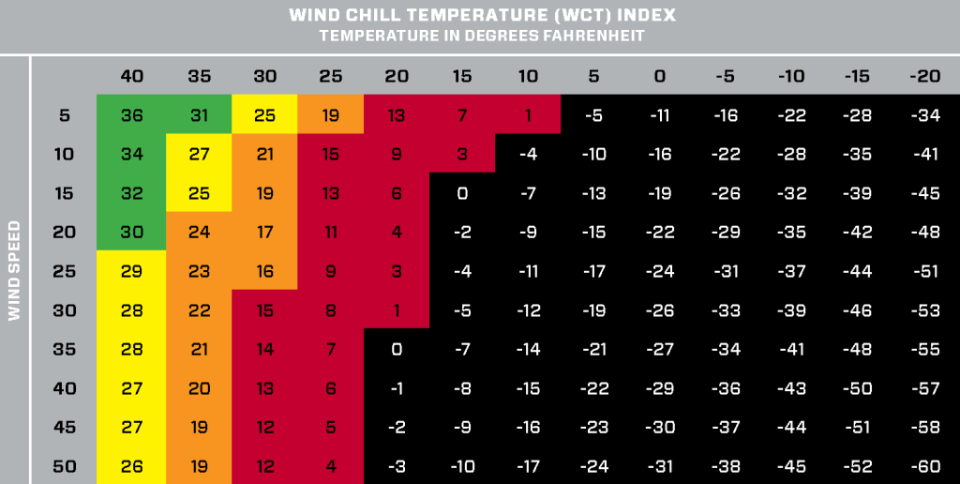
COLD WEATHER POLICY
Though Texas is often associated with warm weather, the state can experience chilly conditions that require thoughtful preparation for activities like soccer. When temperatures drop, it becomes essential for players and coaches to adjust their routines and gear to ensure safety, performance, and enjoyment of the game. That is why we follow guidance from the U.S. Soccer’s Sports Medicine Department on cold weather and related injuries. Their full document of guidelines and WCT estimate can be found HERE.
“The effects of cold weather can impact health and safety during practices and games. The definition of “cold stress” varies across the United States, depending on how accustomed people are to cold weather.”
— U.S. Soccer’s Sports Medicine Department
We will be using the Wind Chill Temperature chart from the National Weather Service to determine what actions need to take place.
Based on the WCT at the fields, we will use the following recommendations:
CITY RESTRICTIONS
The City of Pflugerville also has restrictions on cold weather for their parks that they relay to PAYSL. These restrictions are updated at 4 P.M. during the week and are treated like other park closures. These are the restrictions that the City of Pflugerville has on their parks:
Play Restrictions: Wind Chill 26-32° - 30 minutes of exposure, with a 15 minute break inside. It won’t be possible to be inside of a building at all parks, so this can be substituted with a 15 minute break inside of their parent’s cars.
Play Cancellations: Wind Chill 25° or less - Play will be cancelled for the evening if the Wind Chill is forecast to be 25° or less at any time during scheduled play.
DRESSING IN LAYERS
When it comes to playing soccer in cold weather, dressing properly is one of the most effective ways to stay safe and comfortable. The key is layering, a technique that allows you to stay warm while remaining flexible enough for active play. Here's a quick guide to layering like a pro:
Inner Layer (Wicking Layer):
The base layer is all about keeping you dry. Choose moisture-wicking fabrics like wool or polyester that pull sweat away from your skin. This prevents your body from cooling down too quickly and keeps you comfortable during play.Middle Layer (Insulated Layer):
This is your warmth layer. Fleece or wool works best here, trapping body heat while allowing some breathability. It’s important that this layer isn’t too bulky, so you can still move freely on the field.Outer Layer (Wind and Waterproof):
The outermost layer is your shield against the elements. Look for jackets and pants that are windproof and water-resistant to keep out rain, snow, and cold winds. This layer ensures your inner warmth isn’t compromised by external weather.
For our youngest players in the 4U-6U age range, coats can be worn over their team jerseys to help them stay warm.
For our older players 7U and above, the team jersey needs to be the outermost layer of clothing.
This decision is up to the referee of each game, however, so their decision is ultimately what will determine how the jersey should be worn.
Additional Tips for Cold Weather Play
Flexibility is Key: Layers can be added or removed as temperatures change or your body warms up during play. Make sure players have easy access to their gear to adjust as needed.
Protect Extremities: Don’t forget about gloves, hats or headbands, and thick socks. These small additions can make a big difference in keeping extremities warm and avoiding frostbite.
Stay Dry: Avoid sweating too much before heading outdoors, as damp clothing can cool you down rapidly. If clothing becomes wet during play, replace it immediately with dry gear.
ADJUST WARM-UP ROUTINE
Before play begins, a thorough warm-up routine is essential. An extended warm-up increases blood flow and flexibility, reduces the risk of injuries, and prepares the body for intense activity. Such routines might include dynamic stretching and sport-specific drills to ensure that muscles and joints are ready to perform under cold conditions.
HYDRATION
Alongside proper clothing and warm-ups, maintaining hydration and nutrition remains crucial. Even when the weather is cold, the body loses fluids through sweat and respiration, so regular hydration and consumption of energy-rich snacks help sustain performance and prevent fatigue. If you are thirsty, you are already dehydrated.


